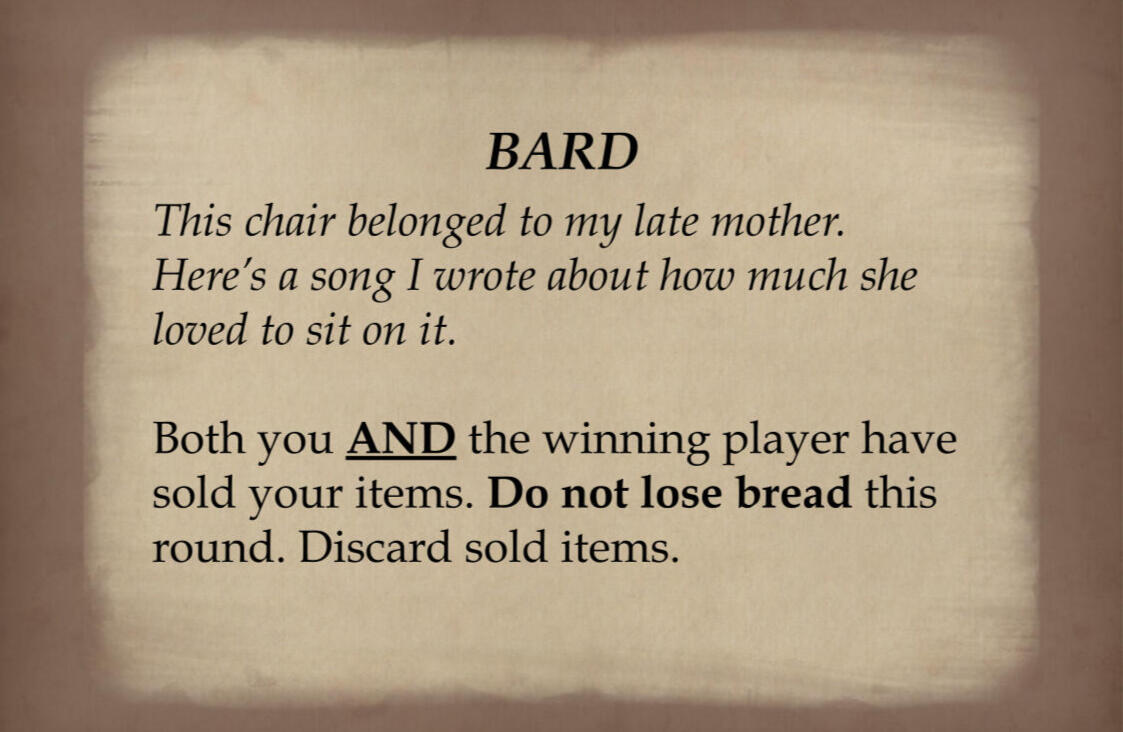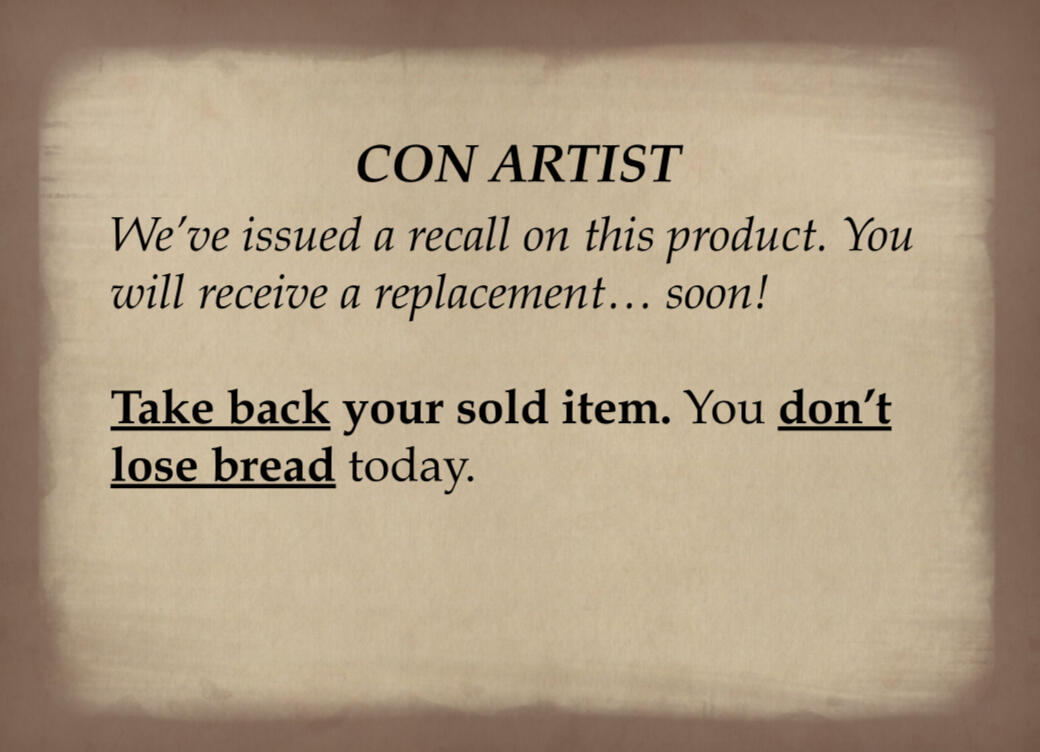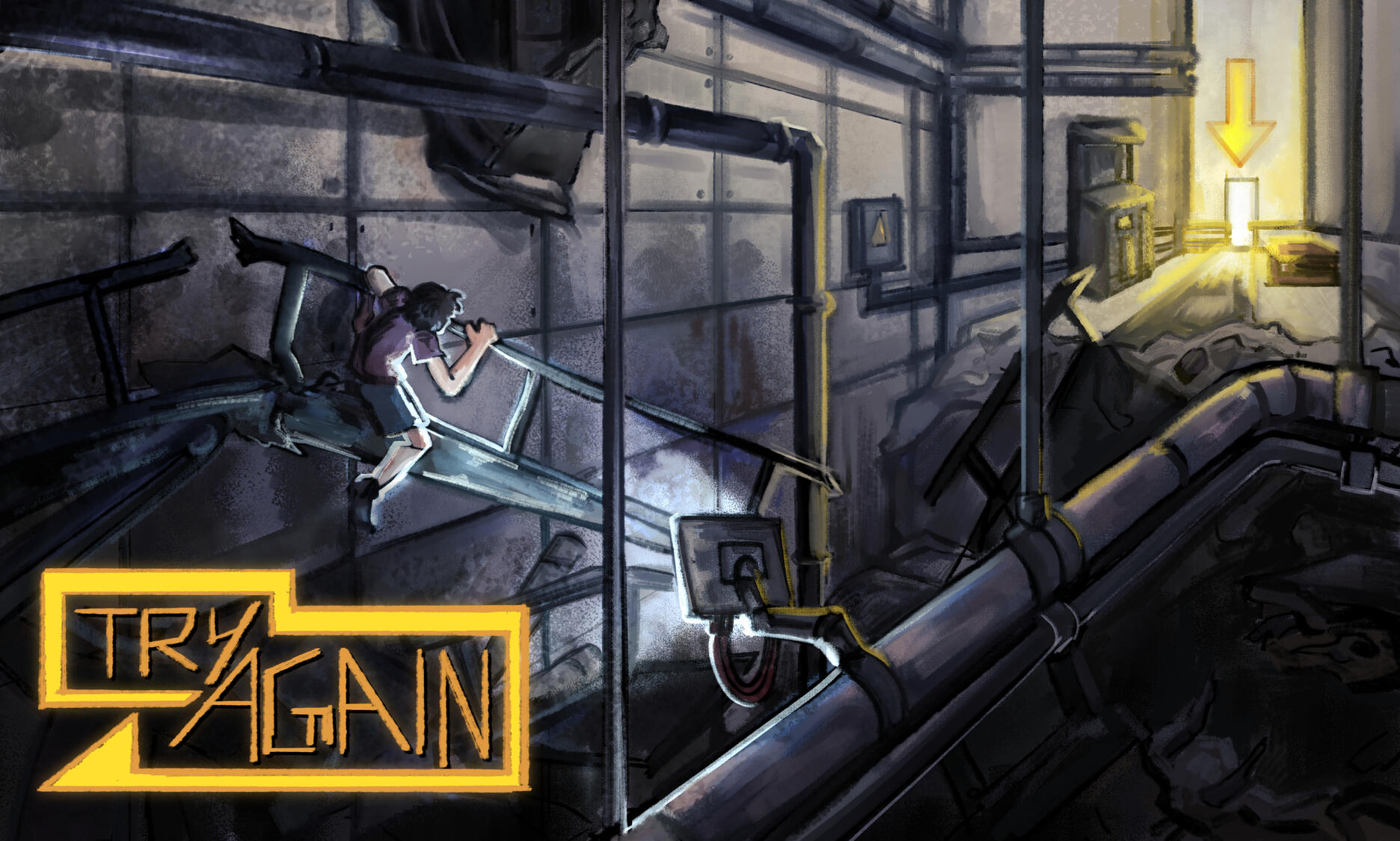Shannon Kilbride
NARRATIVE AND GAME DESIGNER
Projects
Lead Narrative Designer
Third-person action platformer about Bandit, a drill-wielding fox in search of the fabled oasis in the sky.
Narrative Designer
A superhero stimulation where Mantle believes he is following the hero's journey but is actually falling into villainy.
Narrative and Game Designer
A comedic, over-the-top 2D puzzle game following an arsonist-for-hire helping a small town.
Narrative and Systems Designer
Role-playing digital card game about a woman exploring her village to finally face her shadows.
Narrative Designer
A visual novel tackling the consequences of censorship on creativity, friendships, and integrity.
Narrative and Game Designer
Acompetitive board game where players, race to sell items for bread, using sabotage and judgment to outsmart their rivals.
ABOUT
Hello, I'm Shannon Kilbride, a student in the Interactive Media and Games Program at the University of Southern California focusing on studying narrative and game design.I am originally from Cleveland, Ohio but moved to Los Angeles for college. During my time in college, I have had the honor to work on a variety of different games and projects, leaving my mark on each one. In addition, I am the president of the student organization MEGA, a club that strives to teach students about many aspects of game development and connect them with those in the industry.Outside of school and work, I like to write short stories, draw, watch movies, and play video games -- of course -- in my free time. My favorite games are visual novels, roguelikes, and third-person shooters. I essentially enjoy playing while my dog, Ziggy, cuddles with me.
Oasis Blitz
USC Advanced Games Project
Narrative Design Lead
May 2023 - October 2024
About
Oasis Blitz is a 3D action adventure platformer following Bandit, a venturesome fox wielding a drill, and his journey to fulfill a prophecy about an oasis in the sky. Explore a desert planet with floating islands to defeats enemies and find plants to power the drill.
As the narrative design lead, I managed a small team of four and regularly meet with other disciplines regarding the implementation of the narrative.The game is expected for a PC and Mac release on Steam in May 2025.
Narrative
With my position as narrative lead, I woredk closely with the narrative teams and other disciplines to develop the story and characters of the game. My main responsibilities were :
Developed the main storyline, including the setting and characters.
Wrote character sheets, scripts, and barks.
Collaborated with the art department to align the story with the visual aesthetics.
Drafted levels with the director and design team to ensure that the narrative was integrated with the gameplay and level progression.
Worked closely with the engineers to create tools to implement cutscenes and dialogue in the game.
Attended and assisted with voice-over sessions.
Led the narrative team by assigning tasks, conducting brainstorming sessions, and reviewing materials.
Bandit is the protagonist of Oasis Blitz, therefore it was important for me and the director define his characteristics during pre-production. His character bible was essential for writing his dialogue as well as a reference for the animators when animating his mannerisms. This sheet was also used for my collaborations with the sound design team to implement voiceover
The cutscenes of the game are slideshows that include still drawings to tell the story. These cutscenes will play during the beginning and end. The process for developing these are that the narrative team and I will write scripts and then work with the art team for storyboarding.The example I provided is the current version of the opening cutscene.
Critters serve as the supporting characters. More spawn after each level and completed. Their barks give more context to the world and provide side quests for players. I wanted them to motivate the player to interact more with the world and explore alternative paths in levels. I worked with my narrative team to write these barks.
I worked closely with the design team to develop levels. Since there were no cutscenes between levels, it was important for the narrative to develop through character and environment interactions during levels. As we progressed through development, we created blockouts of all the levels before art is implemented. I assisted so I could place characters for Bandit to talk to and objects for him to collect and put in his burrow. Below are blockouts of areas of the first level I helped create.
Mantle
USC MFA Thesis
Narrative Designer
April 2024 - Present
About
Mantle is a 2D simulation superhero game with strategy puzzle-like combat. The protagonist, Mantle, believes he is following the standard hero's journey while ignoring his villainous tendencies. Essentially, the game challenges the player to contemplate what they believe a superhero to be.The game is currently in the full production stage and has a planned release date for Summer 2025.
Narrative
As a game with the narrative as the prime focus, the narrative team and I work tirelessly to develop a story that starts hopeful but slowly becomes gritty. We all wish to create an emotional experience for the player where they end the game questioning what heroism is.My current tasks for this project are:
Pitch ideas for villains encountered throughout the game, including their powers and personality.
Write scripts for post-battle cutscenes that convey Mantle's descent to villainy and the public's questioning of his intentions.
Meet regularly with the art team to review concept designs for villains and the structure of cutscenes to ensure both are cohesive with the narrative.
During pre-production and occasionally production, the narrative team was tasked with pitching villains for the story. Whenever I conceive an idea for a villain, I considered fun, unique powers and abilities. More importantly, I want them to have a personality that pushes Mantle to his limits and their history with other superheroes. For their appearance, I would take some general ideas and then consult the art team so they could use their expertise to share their own ideas.
Cutscenes in Mantle take place on the screen of a laptop, with a news report of the previous battle on one tab and a transcript between Mantle and his creator, Leo, on the other. I am assigned to write these cutscenes. When crafting these, I strive to convey the consequences of the battle (both positive and negative) and both Mantle and Leo's arc from heroes to villains.
Leo is a figure behind the scenes who configures his personality, including his deep desire for recognition, onto Mantle. At the beginning, they have very similar personalities, but as public backlash against Mantle grows, they both descend into villainy but do so differently. I want to convey that Leo is desperate to be considered a hero while Mantle is delusional about his hero status.
Script for a cutscene at the end of Act 2.
work in progress
Mantle is currently in the production phase of development. This page will be updated as development continues.
Cards of Heart
USC MFA Thesis
Narrative Designer, Systems Designer
May 2023 - September 2024
About
Cards of Heart is a role-playing digital card game about a young woman named Amalia confronting her inner shadows. Amalia, who has been experiencing depression and anxiety since the departure of her best friend, learns to process her grief and heal from her painful past. The game takes inspiration from cognitive distortions and its treatments to teach the player techniques to manage their own mental health.Cards of Heart was released to Steam in September 2024 and was meant with positive reviews.
Narrative
There are several narrative designers on Cards of Heart. I specialize in developing the characterization of the enemies, who are called Shadows that are personifications of cognitive distortions.My responsibility as a narrative designer for this project include:
Develop character outlines for the Shadows that included detailed personalities and mannerisms for the art team to reference when creating concept art.
Write scripts for scenes taking place before and after battles.
Craft dialogue for characters during battle such as exchanges between characters and responses to attacks.
Research different cognitive distortions that Shadows symbolize to ensure that the characterization and dialogue correlates with those distortions.
My narrative work for Cards of Heart primarily consists of developing all the Shadows encountered throughout the game. I write character sheets that include descriptions of Shadows as well as their personalities and dialogue throughout battle. These sheets serve as references for me when writing scripts for cutscenes before and after battles. The art team also references such documents when creating concept art.This example is of the Grove Shadow, which is the first shadow the player encounters. The director envisioned the Shadow as an introduction to mindfulness techniques listed in the player's card deck. So for this Shadow, I made its personality, mannerisms, and dialogue a simplistic combination of various cognitive distortions so the player can easily understand what future Shadows may represent.
Systems
Since my narrative works involves in-game card battles, I was also assigned to work as part of the systems design team.As a systems designer, my tasks are:
Create cards for the Shadows.
Collaborate with other systems designers to design the card battle system.
Research cognitive distortions and cognitive behavioral therapy to properly represent them in the card decks.
With regard to my work as a systems designer, I create cards for the Shadows. The statements on the cards are thoughts related to specific cognitive distortions that attack Amalia's hope, empowerment, or connectedness with the present. I write statements and considered that amount of damage each one would do.Since the Grove Shadow serves as a tutorial to card battles, the dialogue exchanges are written to help the player understand the mechanics. Furthermore, some exchanges are examples of Amalia using cognitive behavioral therapy, so I wrote Amalia using CBT and the Shadow's resistance to it.
Brinkmanship
USC MFA Thesis
Narrative Designer
May 2023 - June 2024
About
Brinkmanship is a first-person sci-fi mystery thriller about a spaceship carrying 30,000 people who are on a decades-long journey to colonize a planet when suddenly, the course of the ship has changed. The player must uncover the conspiracy and discover who are their allies and enemies. Player choice will determine whether their efforts are successful or result in disaster.

Narrative
The narrative design process for Brinkmanship includes regular collaboration with the director and other narrative designers through writer's room. We pitch characters and work together to develop the in-game conspiracy.My responsibilities for this project are:
Attend narrative meetings with the director to develop the branching story.
Consider different play-styles when writing the story so all dialogue options are deliberate and make the player feel like they are in control.
Write scripts with branching dialogue in YarnSpinner.
Create supporting characters and their interactions with the player as well as determining their place in the conspiracy.
At the center of Brinkmanship is a conspiracy. It is the duty of the player to uncover the truth and confront those responsible. How they do so it determined by their choices in dialogue and actions throughout the game. As a narrative designer, I have to consider this when developing characters and writing scripts for scenes. YarnSpinner is how scripts are implemented in the game. Using YarnSpinner formatting and syntax allows me to consider player choices and assists me in visualizing possible branches.The script embedded is the player character talking with their parents about the conspiracy they recently discovered. This scene takes place very early in the game, so I wrote dialogue options that vary greatly so the player understands the importance of their choices.
Arson Simulator
USC Games
Narrative and Game Designer
January - June 2023
About
Arson Simulator is a 2D puzzle game where the player takes control of an arsonist-for-hire that takes requests from townspeople to burn and destroy various buildings and structures using kindling and bombs.
My partner and I created and developed the game through our 2023 Spring Semester at USC Games.

Narrative
As the co-creator, I had many duties while developing Arson Simulator, but the disciplines I put most of my focus on were narrative and game design.With narrative design, I wanted to take the silly concept of playing as an arsonist for hire and make that a comedic but surprisingly wholesome story. My responsibilities in regard to narrative included:
Creating the main plot of the game and establishing the tone as amusing and heartwarming.
Designing the personality of the arsonist, the player character.
Developing the setting, a town where the people turn to the arsonist to destroy hated buildings that negatively effect the town.
Writing the dialogue and letters that serve as level instructions.
The story of the game is conveyed through pre-level dialogue and levels that detail the location and possible challenges faced. With the dialogue, I aimed to demonstrate the serious yet compassionate personality of the arsonist. I also wanted the setting to have a story of its own. Between levels, the player sees how residents of a small town are desperate for good changes that they turn to the arsonists. Meanwhile, the arsonist finds fulfillment in completing these requests, as he sees how his actions are bringing the town together.Below is a sample scene that shows the pre-level letter and dialogue from the arsonist.
Another scene I would like to share is the one taking place before the tutorial. The script for this scene contains in-game explanations of the mechanics, controls, and objects encountered. I thought that having these elements explained through a library would fit the humorous tone and also convey the absurdity of the world.
Game Design
With the game design aspect, I worked with my development partner to design the puzzles and mechanics. We also did all the programming, which included creating scripts for the building and fire physics.My main tasks were:
Collaborating with my development partner to conceptualize and design the core mechanics.
Developing the gameplay loop present in all puzzles.
Designing the final three levels by brainstorming how to challenge players and encourage strategizing.
Programming was important to implementing the mechanics of the puzzles in each level. My partner and I collaborated in programming the scripts for the building blocks and their interactions with other blocks and kindling and bombs. We calculated the speed at which fire spreads between blocks and the blast radius of bombs.For level ideation, I created sketches and wrote notes to myself about what would make the level puzzling yet fair and considered what unique challenges the player will encounter. Small changes are made throughout based on player feedback and my own observations of how they interacted with the level. With playtests, I can test whether the level design goals I created were achieved.
The Cleaner
USC MFA Thesis
Narrative Designer
August 2022 - May 2023
About
The Cleaner is a visual novel about severe censorship in the video game industry with a branching narrative. The story and gameplay revolve around Lia, a newly appointed lead designer who faces difficulties in maintaining her creative vision while adhering to the strict censorship regulations. The game allows players to make choices that shape the character relationships and narrative.
Narrative
During production on this project, I worked closely with the other narrative designers as well as the game design team. Due to the branching narrative, my work often involved considering how player choices affected character development.The following were my tasks throughout development:
Wrote dialogue and barks for a Lia that showcased her personality, motivations, and character arc.
Collaborated with the development team to integrate gameplay elements seamlessly into the narrative.
Deliberated with the narrative team on how to convey the story.
Created and wrote prompts and answers for brainstorming minigames.
The goal of the brainstorm minigames is to see what elements of storytelling can be limited be censorship. The four main factors that influence player decision in these minigames are revenue, audience response, critical reception, and reactions from characters. For the first three mentioned, players must determine their priorities or choose to strike a balance among them. It is rather tricky to create a balance, and choosing one over the other has consequences on the final version of the pitch.The fourth factor demonstrates the personalities of the characters. When creating answers to the prompts, I considered words and phrases that would create unique reactions from each character. The wording of the response were also important, as they needed to clearly state what they liked or disliked.
The Cleaner is a visual novel with a branching story. Therefore, the narrative team and I wanted differing story elements and endings that depended on player choices in dialogue. Each narrative designer was assigned a character to write dialogue for, and my character was Lia. Since she is the main playable character, I had to consider how her personality would change according to certain player choices and how those relate to the themes of the game. Specifically, I wanted to her dialogue to represent possible reactions to censorship. She either follows the constraints and compromises her vision or stays true to herself.
Sell to survive
USC Games
Narrative and Game Designer
November - December 2021
About
Sell to Survive is a board game where players play as villagers that compete to sell their items to villagers in exchange for bread. The game takes inspiration from judgement-based games but with an added twist of sabotage and competitive mechanics.I developed the game with my classmates for our final project for a class.In 2023, Sell to Survive was selected to be exhibited at the USC Games Expo.
Narrative
This board game originated as a final project for the class Game Design Workshop at the University of Southern California. The game director had begun development for the game as a solo assignment for the class earlier in the semester and pitched it for a final project. Now, with multiple people working on the game, the team and I primarily discussed improvements and implemented feedback from playtests.As the narrative designer, my responsibilities were:
Creating the main narrative, including the world and its characters.
Working closely with the game designers to implement the narrative through the skill cards.
Writing the rule book.
Assisted team members in conducting playtesting sessions.
Before I joined the team, the director imagined the concept of the game as the narrative, which was street rats competing to sell items to villagers in order to survive. I thought the concept was extremely solid, so I used that as a basis for crafting the story further. Since the story is told through gameplay, my tasks were to ensure the narrative was implemented into the mechanics.The rule book introduces players to the concept and mechanics, so I used it to explain those as well as the main story and characters. Taking the preexisting set of rules (and the additions made after playtests), I made sure to provide clear and concise instructions that guided players through the intricacies of the game, ensuring a smooth and enjoyable gaming experience. In addition, I established that the game concept is the basis of the narrative. This way, the player knows that they will experience the competitiveness and desperation of selling random items that the player characters are also experiencing.Playtesting sessions gave me information on how to better explain and clarify the narrative. A major point of feedback was confusion regarding the intentions of the villagers. I used the feedback as an opportunity to flesh out those characters by naming them and hinting at the possible item types they prefer.
Draft of the rule book. This version shows the board setup and explains the story and mechanics.
Finalized version of the rule book, now featuring more concise introductions and descriptions of the villagers.
Skill cards add to the competitiveness. When activated, players give themselves certain advantages. The game designers worked on creating and refining these cards, and I collaborated with them regularly. I saw the cards as a system to tell the narrative. So, I added thematic narratives and strategic depth to them as to create player engagement within the world of the game. The name of skill cards are reminiscent of terms from the Medieval Era. Before the explanation of the effect is a small passage fitting to the card name that emphasizes the somber yet humorous tone.
Examples of a final version of a skill card.
Implementation
Playthrough of a physical copy.
Other work
While the following works do not fit my main page, they are still examples of my passion for video games and art.
Concept Artist
Concept Project
Try Again
USC Advanced Games Project
Concept Artist
August 2022 - May 2023
About
Try Again is 2.5D platformer about a game designer's struggles to finish her game and impress her developers. The player experiences her distress by playing as Benny, a test character trapped in endless prototypes.I joined the team as a concept artist. I worked closely with the director and members of the art team to create ideas fitting the concept of the game and its comedic tone.
concept art
The Outsiders
Game Concept
January 2023 - May 2023
About
For this semester-long project, I was tasked with developing various art for an inventive take on an existing property. I decided to adapt the classic S.E Hinton novel The Outsiders.
Throughout the semester, I created and developed character reference sheets, environmental art, and key art for my version of the story under the guidance of professor Zoë van Dijk.
Key Art
















































